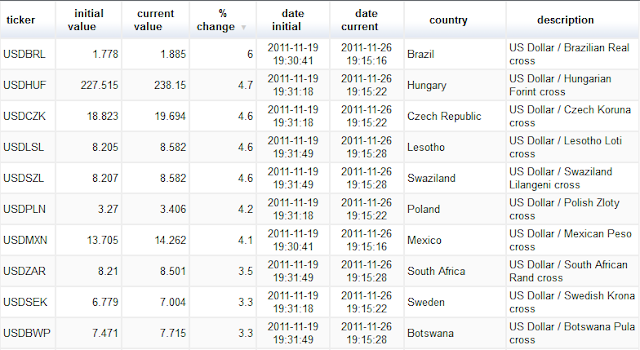In the forex markets, the US $ weakened against more than 90% of the world's currencies and the DXY (U.S. $ index) declined 1%.
 |
| Click here to go to the live chart. |
In the equity markets, more than half of the global equity indexes we tracked had gains of over 3%. The ratio would've been much higher except that the announcement came after many Asian stock markets were already closed. Here's the list of the top performing benchmark equity indexes from Wednesday's session:
 |
| Click here to go to the live chart. |
In the commodities sector, copper surged over 5%, silver was up almost 3%, gold gained 2% and WTI crude closed over $100/barrel.
Now going back to the title of this post, the Hungarian Traded Index was the best performing benchmark equity index on the planet (taking into consideration that the central bank intervention news hadn't been digested in Asia yet), surging 6.9%. It's also interesting to note that the Hungarian Forint was the 2nd best performing currency, strengthening 2.6% against the U.S. Dollar. Could it be that the central banks' were pushed into action because of an imminent default in either Hungarian sovereign debt or a Hungarian bank? The fact that the intervention occurred just before the open of the European markets would add ammunition to this argument.
The Hungarian economy has been on the ropes. Its sovereign credit rating was recently downgraded to junk by Moody's. The Forint had weakened 30% this year vs. the dollar and its credit default swaps are the 7th highest priced sovereign CDS of the ones we track (look at the 2nd table in this post). With today's global economy teetering on the edge even a country like Hungary, with a mid-sized GDP of $130 billion (according to the IMF), has the potential of setting off a damaging shock wave. When you add in the fact that the banking systems of several Eurozone countries (some like Austria, Italy and Belgium have plenty of their own problems) are dangerously exposed to the Hungarian economy, one can see why the global financial powers would want take aggressive action to avoid a complete Hungarian collapse. The following chart is a little stale (from June 2010) but it sheds some light on foreign banking system exposure to Hungary (source BNP Paribas):
Imagine the following countries as a stack of plates: Greece, Cyprus, Hungary, Italy, Ukraine, Belgium, Ireland, Cyprus, Portugal, Spain and Austria. Then imagine the global financial powers-that-be attempting to juggle them all without letting any one of them slip to the floor. It may very well be that on Wednesday the Hungarian plate slipped through a hand and was caught with a foot.

















































